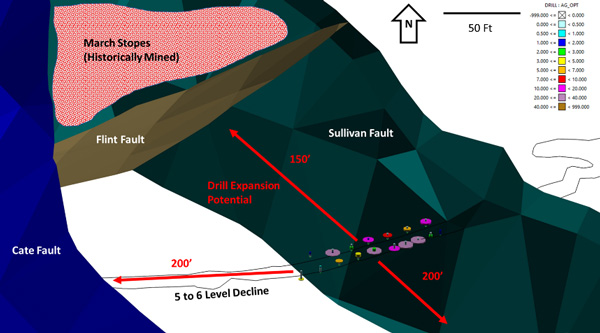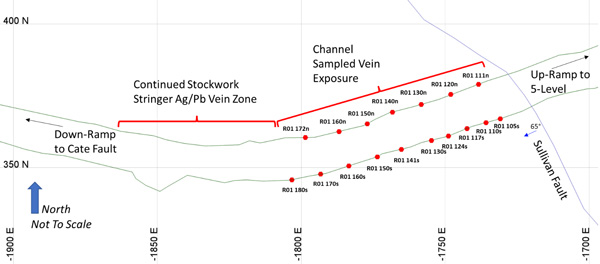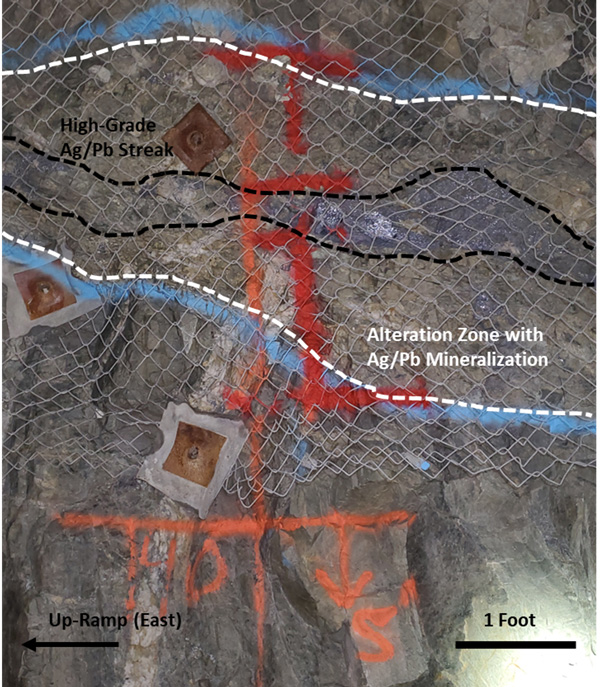Bunker Hill to Host Live Interactive 6ix Summit on Monday, August 15 @ 11:00am ET / 8:00am PT
HIGHLIGHTS
- New high-grade silver and lead vein system discovered during development of an underground ramp connecting Levels 5 and 6 in the upper part of the mine
- Structure remains open along both strike and dip forming an attractive silver exploration target
- Highlights Include: 1.3 Ft @ 10.87 t Oz/t Ag, 33.05% Pb (Including 0.6 Ft 23.45 t Oz/t Ag, 71.43% Pb) & 3.4 Ft @ 4.52 t Oz/t Ag, 14.02% Pb (Including 0.4 Ft 26.25 t Oz/t Ag, 82.17% Pb)
- CEO Sam Ash and CFO David Wiens to host interactive 6ix investor event on Monday, August 15 at 11:00am ET / 8:00am PT. Investors are invited to register at: [LINK]
|
TORONTO, August 11, 2022 – Bunker Hill Mining Corp. (the “Company”) (CSE: BNKR, OTCQB: BHLL) is pleased to announce that it has discovered a previously unknown high-grade silver-lead (Ag/Pb) vein system as part of its on-going underground mine development activities.
Sam Ash, CEO stated: “Encountering this new vein through our current development in the upper part of the mine highlights the potential to add additional high-value tons to our existing mineral resources. Although extensively developed, much of the mine was not explored in a modern sense implying potentially significant upside to be discovered. Silver-lead vein style mineralization was the primary source of Bunker Hill’s early production, and we look forward to continuing to explore this emerging new target concurrent with the restart of operations.”

Figure 1: Oblique view of channel sampled vein in Bunker Hill 5 to 6 level decline. Assay results shown in Silver Troy Oz per Short Ton (OPT). View is due north; slice width is 100’.
Located between two major fault structures, the vein is considered to be analogous to historically mined, low-angle extension structures which formed part of the “J” vein stopes. The “J” stopes historically produced over 1.1Mt with an average grade of 7.59 OPT Ag, 9.88% Pb and 0.59% Zn - therefore this newly discovered vein forms an attractive high-grade silver-lead target. The vein was intersected approximately 600 feet into the 1,600-foot planned decline ramp connecting the existing 5-level and 6-levels of the mine. Bunker Hill geologists have now completed a channel sampling program on the accessible portions of the structure (Table 1).
Mineralization from the channel sampled vein portion continues as a high-angle vein structure associated with the Sullivan fault to the east, providing an additional high priority exploration target, as historic stoping areas associated with high-angle vein mineralization on average showed substantially wider structural widths. Vein mineralization associated with the Sullivan fault formed the footwall mineralization to the historic March stopes which produced a total of 4.7Mt at an average grade of 5.22 OPT Ag, 12.03% Pb and 2.25% Zn. Stockwork vein mineralization extending from the extension structure to the west is seen to truncate into the foot wall of the Cate fault, but with a lack of historical development and drilling west of the Cate (hanging wall) the possibility to discover previously un-developed hybrid Silver-Lead-Zinc style mineralization remains open along both strike and dip.
The proximity of the structure to existing 5-level workings provides a readily available drill platform from which to further explore the extent of the vein. The Company plans to follow up with drill targeting of both the extension vein and high-angle target zones upon further advancement of drift development.
Table 1: Channel Sample Assay Results from Decline Vein Exposure
(All channels oriented vertical, see Figure 2 for collar locations. Reported widths are sampled widths and do not reflect true widths as there is currently insufficient data to calculate true orientation in space)
Channel
ID |
Width
(Ft) |
Ag
(g/t) |
Ag
(OPT) |
Pb
(%) |
Zn
(%) |
| r01_105s |
2.8 |
60 |
1.74 |
4.65 |
0.31 |
| |
| r01_110s |
2.5 |
41 |
1.18 |
3.89 |
0.27 |
| |
| r01_117s |
1.3 |
373 |
10.87 |
33.05 |
0.07 |
| Inc. |
0.6 |
804 |
23.45 |
71.43 |
0.11 |
| |
| r01_124s |
0.7 |
714 |
20.83 |
67.26 |
0.14 |
| |
| r01_130s |
0.7 |
302 |
8.81 |
27.73 |
0.11 |
| Inc. |
0.3 |
673 |
19.63 |
61.70 |
0.20 |
| |
| r01_141s |
3.4 |
155 |
4.52 |
14.02 |
0.10 |
| Inc. |
0.4 |
900 |
26.25 |
82.17 |
0.06 |
| |
| r01_150s |
1.5 |
126 |
3.68 |
9.84 |
1.18 |
| |
| r01_160s |
0.9 |
100 |
2.91 |
9.80 |
0.20 |
| |
| r01_111n |
0.9 |
351 |
10.24 |
38.99 |
0.22 |
| |
| r01_120n |
1.9 |
81 |
2.37 |
8.08 |
0.11 |
| |
| r01_130n |
0.9 |
114 |
3.32 |
9.17 |
0.61 |
| Inc. |
0.4 |
247 |
7.20 |
19.95 |
1.29 |
| |
| r01_140n |
2.2 |
109 |
3.17 |
8.63 |
0.13 |
| Inc. |
0.3 |
505 |
14.73 |
39.36 |
0.07 |
| |
| r01_150n |
1.2 |
78 |
2.28 |
6.90 |
1.02 |
| |
| r01_160n |
0.8 |
376 |
10.96 |
29.69 |
0.17 |
| Inc. |
0.3 |
895 |
26.10 |
74.73 |
0.17 |
| |
| r01_172n |
1.4 |
36 |
1.05 |
2.76 |
1.27 |
| |
| r01_170s |
0.3 |
67 |
1.95 |
4.03 |
2.68 |
| |
| r01_180s |
0.3 |
127 |
3.70 |
11.30 |
4.19 |
Channel samples were analyzed by ALS USA Inc utilizing an ore-grade, 4-acid digestion (OG62) with titrations (Pb-VOL70) for lead overlimit analysis.
Bunker Hill geologists conducted a channel-chip sampling program along the length of the vein exposure on approximate 10’ intervals for a total of 17 samples between both the north and south rib. Samples were taken vertically while respecting mineralogical and structural boundaries of the overall structure width and internal high-grade core mineralization. The results from this sampling program will be used to guide future exploration efforts with the goal of bringing the mineralized material into Bunker Hill’s mineral resource.

Figure 2: Plan map of channel sample locations with respect to current decline drift and Sullivan fault. Grid in local mine coordinates (Ft).
Vein mineralization includes a high-grade core zone containing massive, coarse to fine grained galena as the dominant silver and lead mineral with trace amounts of zinc within a broader structural zone, containing similar mineralization disseminated as sulfide pods in a gangue of quartz and siderite stockwork in bleached and sericitized wall rock.
Similar low-angle mineralization in extension structures related to dip-slip movement on the “J” fault is well documented through previous geologic studies and detailed mapping. Stoping on the “J” vein system, located 1,500’ to the east of the newly discovered decline mineralization dominantly on the 19 through 23 levels of the mine, produced 1.1Mt of material averaging 7.59 OPT Ag, 9.88% Pb and 0.59% Zn.

Figure 3: Channel sample across mineralized structure showing high-grade core mineralization and larger complete structural width. Image is looking south.
Mineralized silver-lead extension structures similar to the one encountered are repeatedly reported throughout the mine’s historical literature and represent attractive, high value in-mine exploration targets.
QUALIFIED PERSON AND QUALITY ASSURANCE/QUALITY CONTROL
Mr. Scott E. Wilson, CPG, President of RDA and a consultant to the Company, is an independent “qualified person” as defined by NI 43-101 and is acting as the qualified person for the Company. He has reviewed and approved the technical information summarized in this news release.
All samples were sealed in shipping pails and sent to ALS USA Inc’s Mineral’s Division in Twin Falls, ID for sample preparation and ALS’s Vancouver location for analytical services. ALS holds ISO/IEC 17025 accreditation. Analytical accuracy is monitored by the analysis of certified reference material, blank material and replicate samples. Bunker Hill inserts independent certified reference material and certified blank material as an independent QAQC protocol in line with standard industry practice. ALS USA Inc is independent of Bunker Hill.
The Qualified Person has verified the information disclosed herein, including the sampling, preparation, security and analytical procedures underlying such information, and is not aware of any significant risks and uncertainties that could be expected to affect the reliability or confidence in the information discussed herein.
ABOUT BUNKER HILL MINING CORP.
Under new Idaho-based leadership the Bunker Hill Mining Corp, intends to sustainably restart and develop the Bunker Hill Mine as the first step in consolidating a portfolio of North American mining assets with a focus on silver. Information about the Company is available on its website, www.bunkerhillmining.com, or within the SEDAR and EDGAR databases.
For additional information contact:
David Wiens, CFA
CFO & Corporate Secretary
+1 208 370 3665
ir@bunkerhillmining.com
Cautionary Statements
Certain statements in this news release are forward-looking and involve a number of risks and uncertainties. Such forward-looking statements are within the meaning of that term in Section 27A of the Securities Act of 1933, as amended, and Section 21E of the Securities Exchange Act of 1934, as amended, as well as within the meaning of the phrase ‘forward-looking information’ in the Canadian Securities Administrators’ National Instrument 51-102 – Continuous Disclosure Obligations. Forward-looking statements are not comprised of historical facts. Forward-looking statements include estimates and statements that describe the Company’s future plans, objectives or goals, including words to the effect that the Company or management expects a stated condition or result to occur. Forward-looking statements may be identified by such terms as “believes”, “anticipates”, “expects”, “estimates”, “may”, “could”, “would”, “will”, or “plan”. Since forward-looking statements are based on assumptions and address future events and conditions, by their very nature they involve inherent risks and uncertainties. Although these statements are based on information currently available to the Company, the Company provides no assurance that actual results will meet management’s expectations. Risks, uncertainties and other factors involved with forward-looking information could cause actual events, results, performance, prospects and opportunities to differ materially from those expressed or implied by such forward-looking information.
Forward looking information in this news release includes, but is not limited to, the Company’s intentions regarding its objectives, goals or future plans and statements, the future exploration of the new silver-lead vein, the expected outcome of future exploration of the new silver-lead vein and the Company bringing the mineralized material from the new silver-lead vein into its mineral resource. Factors that could cause actual results to differ materially from such forward-looking information include, but are not limited to: the ability to predict and counteract the effects of COVID-19 on the business of the Company, including but not limited to the effects of COVID-19 on the price of commodities, capital market conditions, restriction on labour and international travel and supply chains; failure to identify mineral resources; failure to convert estimated mineral resources to reserves; the inability to complete a feasibility study which recommends a production decision; the preliminary nature of metallurgical test results; the Company’s ability to restart and develop the Bunker Hill Mine and the risks of not basing a production decision on a feasibility study of mineral reserves demonstrating economic and technical viability, resulting in increased uncertainty due to multiple technical and economic risks of failure which are associated with this production decision including, among others, areas that are analyzed in more detail in a feasibility study, such as applying economic analysis to resources and reserves, more detailed metallurgy and a number of specialized studies in areas such as mining and recovery methods, market analysis, and environmental and community impacts and, as a result, there may be an increased uncertainty of achieving any particular level of recovery of minerals or the cost of such recovery, including increased risks associated with developing a commercially mineable deposit with no guarantee that production will begin as anticipated or at all or that anticipated production costs will be achieved; failure to commence production would have a material adverse impact on the Company's ability to generate revenue and cash flow to fund operations; failure to achieve the anticipated production costs would have a material adverse impact on the Company's cash flow and future profitability; delays in obtaining or failures to obtain required governmental, environmental or other project approvals; political risks; changes in equity markets; uncertainties relating to the availability and costs of financing needed in the future; the inability of the Company to budget and manage its liquidity in light of the failure to obtain additional financing, including the ability of the Company to complete the payments pursuant to the terms of the agreement to acquire the Bunker Hill Mine Complex; inflation; changes in exchange rates; fluctuations in commodity prices; delays in the development of projects; capital, operating and reclamation costs varying significantly from estimates and the other risks involved in the mineral exploration and development industry; and those risks set out in the Company’s public documents filed on SEDAR. Although the Company believes that the assumptions and factors used in preparing the forward-looking information in this news release are reasonable, undue reliance should not be placed on such information, which only applies as of the date of this news release, and no assurance can be given that such events will occur in the disclosed time frames or at all. The Company disclaims any intention or obligation to update or revise any forward-looking information, whether as a result of new information, future events or otherwise, other than as required by law. No stock exchange, securities commission or other regulatory authority has approved or disapproved the information contained herein.
Cautionary Note to United States Investors Concerning Estimates of Measured, Indicated and Inferred Resources
This press release has been prepared in accordance with the requirements of the securities laws in effect in Canada, which differ from the requirements of U.S. securities laws. Unless otherwise indicated, all resource and reserve estimates included in this press release have been disclosed in accordance with NI 43-101 and the Canadian Institute of Mining, Metallurgy, and Petroleum Definition Standards on Mineral Resources and Mineral Reserves. NI 43-101 is a rule developed by the Canadian Securities Administrators which establishes standards for all public disclosure an issuer makes of scientific and technical information concerning mineral projects. Canadian disclosure standards, including NI 43-101, differ significantly from the requirements of the United States Securities and Exchange Commission (“SEC”), and resource and reserve information contained in this press release may not be comparable to similar information disclosed by U.S. companies. In particular, and without limiting the generality of the foregoing, the term “resource” does not equate to the term “reserves”. Under U.S. standards, mineralization may not be classified as a “reserve” unless the determination has been made that the mineralization could be economically and legally produced or extracted at the time the reserve determination is made. The SEC’s disclosure standards normally do not permit the inclusion of information concerning “measured mineral resources”, “indicated mineral resources” or “inferred mineral resources” or other descriptions of the amount of mineralization in mineral deposits that do not constitute “reserves” by U.S. standards in documents filed with the SEC. Investors are cautioned not to assume that any part or all of mineral deposits in these categories will ever be converted into reserves. U.S. investors should also understand that “inferred mineral resources” have a great amount of uncertainty as to their existence and great uncertainty as to their economic and legal feasibility. It cannot be assumed that all or any part of an “inferred mineral resource” will ever be upgraded to a higher category. Investors are cautioned not to assume that all or any part of an “inferred mineral resource” exists or is economically or legally mineable. Disclosure of “contained ounces” in a resource is permitted disclosure under Canadian regulations; however, the SEC normally only permits issuers to report mineralization that does not constitute “reserves” by SEC standards as in-place tonnage and grade without reference to unit measures. The requirements of NI 43-101 for disclosure of “reserves” are also not the same as those of the SEC, and reserves disclosed by the Company in accordance with NI 43-101 may not qualify as “reserves” under SEC standards. Accordingly, information concerning mineral deposits contained in our website may not be comparable with information made public by companies that report in accordance with U.S. standards.




